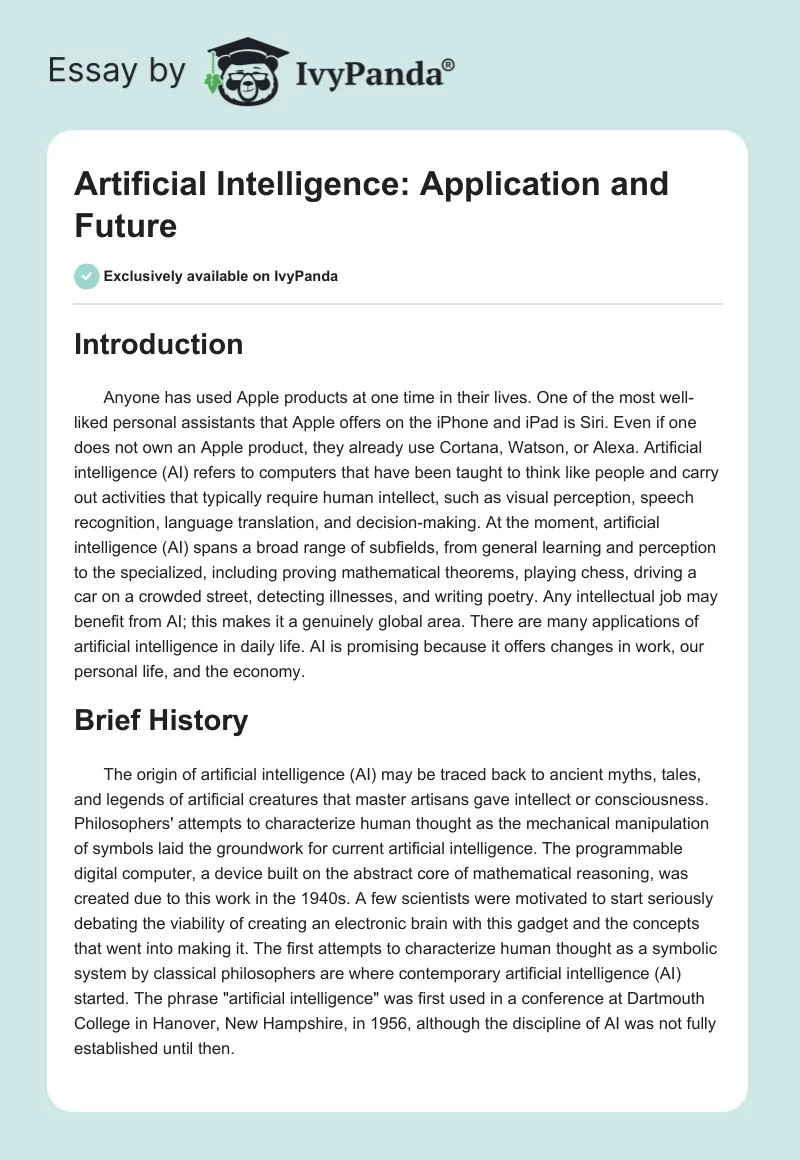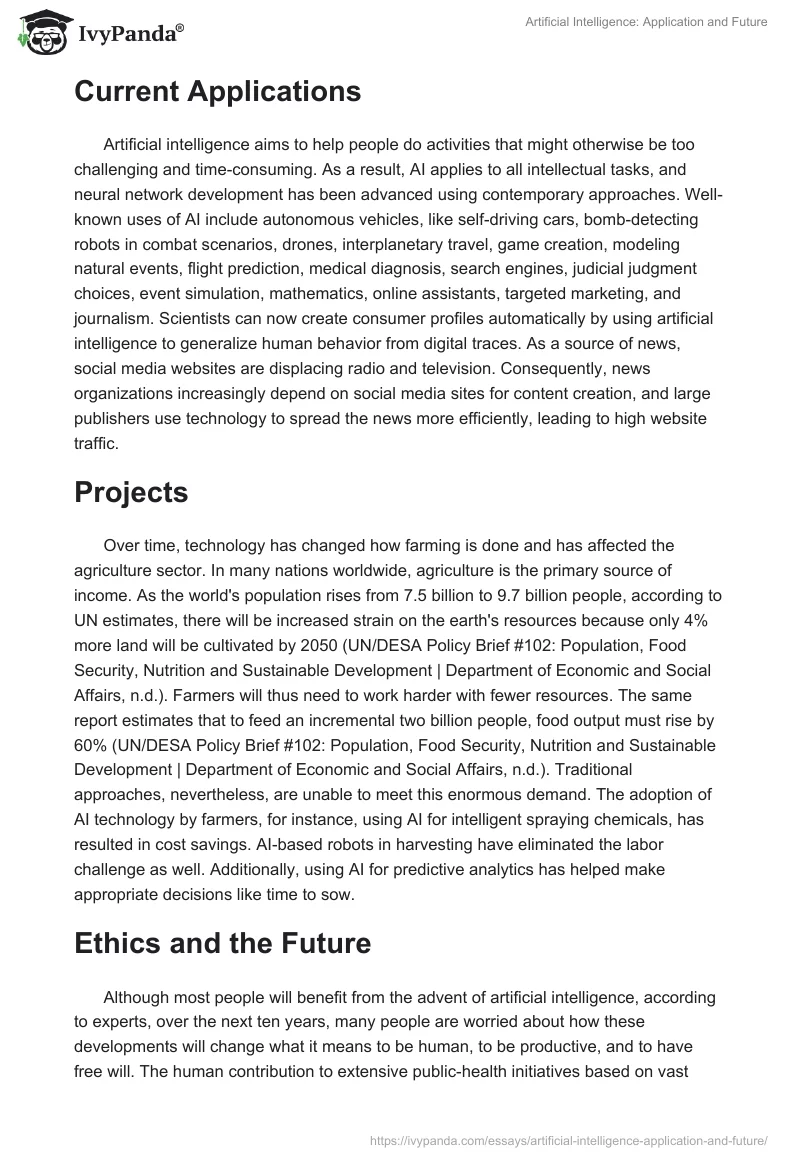Introduction
Anyone has used Apple products at one time or another. Siri is one of the most well-liked personal assistants that Apple offers on the iPhone and iPad. Even if one does not own an Apple product, they already use Cortana, Watson, or Alexa. Artificial intelligence (AI) refers to computers taught to think like people and carry out activities that typically require human intellect, such as visual perception, speech recognition, language translation, and decision-making.
At the moment, artificial intelligence (AI) spans a broad range of subfields, from general learning and perception to the specialized, including proving mathematical theorems, playing chess, driving a car on a crowded street, detecting illnesses, and writing poetry. Any intellectual job may benefit from AI; this makes it a genuinely global area. There are many applications of artificial intelligence in daily life. AI is promising because it offers changes in work, our personal life, and the economy.
Brief History
The origin of artificial intelligence (AI) may be traced back to ancient myths, tales, and legends of artificial creatures that master artisans gave intellect or consciousness. Philosophers’ attempts to characterize human thought as the mechanical manipulation of symbols laid the groundwork for current artificial intelligence. The programmable digital computer, a device built on the abstract core of mathematical reasoning, was created due to this work in the 1940s. A few scientists were motivated to start seriously debating the viability of creating an electronic brain with this gadget and the concepts that went into making it. The first attempts to characterize human thought as a symbolic system by classical philosophers are where contemporary artificial intelligence (AI) started. The phrase “artificial intelligence” was first used in a conference at Dartmouth College in Hanover, New Hampshire, in 1956, although the discipline of AI was not fully established until then.
Current Applications
Artificial intelligence aims to help people do activities that might otherwise be too challenging and time-consuming. As a result, AI applies to all intellectual tasks, and neural network development has been advanced using contemporary approaches. Well-known uses of AI include autonomous vehicles, like self-driving cars, bomb-detecting robots in combat scenarios, drones, interplanetary travel, game creation, modeling natural events, flight prediction, medical diagnosis, search engines, judicial judgment choices, event simulation, mathematics, online assistants, targeted marketing, and journalism. Scientists can now create consumer profiles automatically by using artificial intelligence to generalize human behavior from digital traces. As a source of news, social media websites are displacing radio and television. Consequently, news organizations increasingly depend on social media sites for content creation, and large publishers use technology to spread the news more efficiently, leading to high website traffic.
Projects
Over time, technology has changed how farming is done and has affected the agriculture sector. In many nations worldwide, agriculture is the primary source of income. As the world’s population rises from 7.5 billion to 9.7 billion people, according to UN estimates, there will be increased strain on the earth’s resources because only 4% more land will be cultivated by 2050 (UN/DESA Policy Brief #102: Population, Food Security, Nutrition and Sustainable Development | Department of Economic and Social Affairs, n.d.). Farmers will thus need to work harder with fewer resources. The same report estimates that to feed an incremental two billion people, food output must rise by 60% (UN/DESA Policy Brief #102: Population, Food Security, Nutrition and Sustainable Development | Department of Economic and Social Affairs, n.d.). Traditional approaches, nevertheless, are unable to meet this enormous demand. The adoption of AI technology by farmers, for instance, using AI for intelligent spraying chemicals, has resulted in cost savings. AI-based robots in harvesting have eliminated the labor challenge as well. Additionally, using AI for predictive analytics has helped make appropriate decisions like time to sow.
Ethics and the Future
Although most people will benefit from the advent of artificial intelligence, according to experts, over the next ten years, many people are worried about how these developments will change what it means to be human, to be productive, and to have free will. The human contribution to extensive public-health initiatives based on vast volumes of data that may be gathered in the upcoming years about anything from diet to individual genomes will be enhanced by artificial intelligence. However, some ethical issues might arise with the benefits and efficiencies of AI algorithms.
Most AI technologies are now in the hands of profit-driven businesses or power-hungry governments. The computerized systems that make decisions for individuals sometimes lack values and ethics. These networks are interconnected on a global scale and are challenging to control. Additionally, machine intelligence will remain disruptive to all facets of human employment due to its efficiency and other financial benefits. While some anticipate creating new employment, others are concerned about significant job losses, expanding economic disparities, and societal unrest, including populist revolutions. Moreover, due to the rapid development of unmanned military applications and weaponized knowledge, falsehoods and propaganda may be used to destabilize human groupings severely. Some expect increased destruction of established sociopolitical systems and the potential for significant human casualties. Others worry about cybercriminals’ access to financial systems.
Conclusion
In conclusion, Can AI take over the world in that there will be a total replacement of humans in places? How long do you think it will take before this happens? Our daily lives are incorporating artificial intelligence, which is developing quickly. AI is becoming increasingly popular faster, changing how we live, engage, and enhance consumer experiences. AI influences our decisions whether we use cell phones, browse the internet, or make purchases online. This technology will become more widespread and utilized frequently in the military, education, transportation, and medical fields.
Reference
UN/DESA Policy Brief #102: Population, Food Security, Nutrition and Sustainable Development | Department of Economic and Social Affairs. (n.d.). United Nations. Web.


